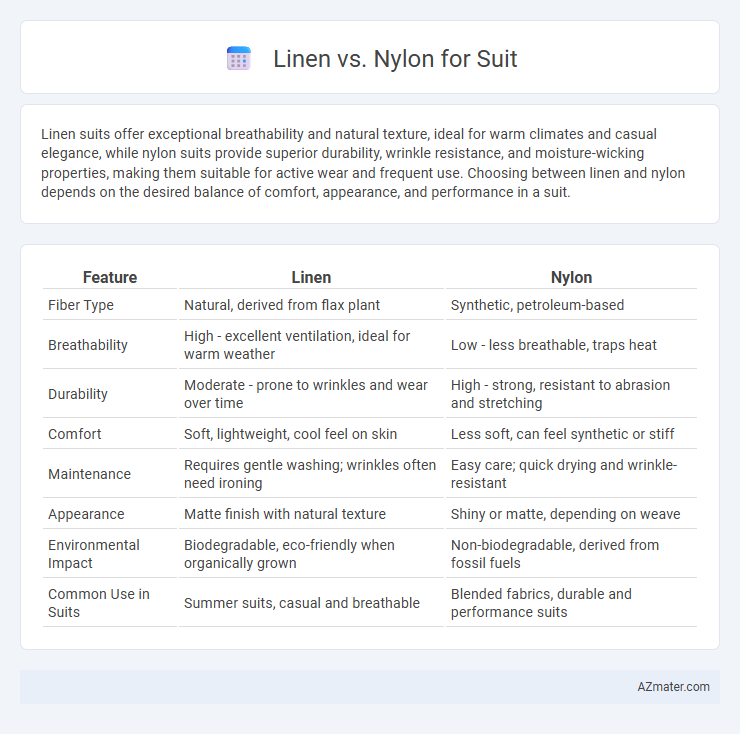Linen suits offer exceptional breathability and natural texture, ideal for warm climates and casual elegance, while nylon suits provide superior durability, wrinkle resistance, and moisture-wicking properties, making them suitable for active wear and frequent use. Choosing between linen and nylon depends on the desired balance of comfort, appearance, and performance in a suit.
Table of Comparison
| Feature | Linen | Nylon |
|---|---|---|
| Fiber Type | Natural, derived from flax plant | Synthetic, petroleum-based |
| Breathability | High - excellent ventilation, ideal for warm weather | Low - less breathable, traps heat |
| Durability | Moderate - prone to wrinkles and wear over time | High - strong, resistant to abrasion and stretching |
| Comfort | Soft, lightweight, cool feel on skin | Less soft, can feel synthetic or stiff |
| Maintenance | Requires gentle washing; wrinkles often need ironing | Easy care; quick drying and wrinkle-resistant |
| Appearance | Matte finish with natural texture | Shiny or matte, depending on weave |
| Environmental Impact | Biodegradable, eco-friendly when organically grown | Non-biodegradable, derived from fossil fuels |
| Common Use in Suits | Summer suits, casual and breathable | Blended fabrics, durable and performance suits |
Introduction to Linen and Nylon Suits
Linen suits offer exceptional breathability and a natural, lightweight feel, making them ideal for warm weather and casual settings. Nylon suits provide durability, wrinkle resistance, and moisture-wicking properties, suited for active wear and travel. Understanding the inherent fabric qualities helps in choosing the right suit for comfort, style, and functionality.
Fabric Origins: Natural vs Synthetic
Linen fabric originates from the flax plant, making it a natural fiber known for breathability and moisture-wicking properties, ideal for warm-weather suits. Nylon, a synthetic fabric derived from petrochemicals, offers durability, elasticity, and resistance to wrinkles and abrasions, commonly used in suit blends for enhanced longevity. Choosing linen emphasizes eco-friendly, breathable qualities, while nylon prioritizes strength and wrinkle resistance in suit construction.
Breathability and Comfort Comparison
Linen offers superior breathability due to its natural fibers, allowing air to circulate freely and keeping the wearer cool in warm weather. Nylon, a synthetic material, is less breathable and tends to trap heat and moisture, which may cause discomfort during prolonged wear. For suits prioritizing comfort in hot climates, linen remains the preferred choice for its lightweight and moisture-wicking properties.
Durability and Wear Resistance
Linen suits offer natural breathability but tend to be less durable and prone to wrinkles, making them ideal for lightweight, casual wear rather than heavy use. Nylon suits provide superior durability and wear resistance due to their synthetic fibers, making them resistant to abrasion, stretching, and fading. For prolonged use and robust performance, nylon blends often outperform pure linen in maintaining structure and appearance over time.
Wrinkle Resistance and Maintenance
Nylon suits offer superior wrinkle resistance compared to linen, making them ideal for maintaining a crisp, polished look throughout the day. Linen fabric, while breathable and comfortable, tends to wrinkle easily and requires frequent ironing or steaming to stay presentable. Nylon suits demand less maintenance overall, often being machine washable and quick-drying, unlike the delicate care required to preserve linen's natural texture.
Style and Appearance: Texture and Drape
Linen suits offer a distinctive textured appearance with a natural, breathable fabric that drapes loosely, creating a relaxed yet stylish look ideal for warm weather. Nylon suits typically have a smoother, shinier surface with a more structured drape, providing a sleek and polished aesthetic suitable for formal occasions. The choice between linen and nylon significantly influences the overall style, with linen emphasizing casual elegance and nylon emphasizing sharpness and durability.
Suitability for Seasons and Climates
Linen suits excel in hot and humid climates due to their natural breathability and moisture-wicking properties, making them ideal for summer and tropical environments. Nylon suits, often blended with other fibers, provide durability and wrinkle resistance but can trap heat, limiting their comfort in warmer seasons. For year-round versatility, blends that include nylon offer lightweight warmth and structure suitable for cooler climates, while pure linen remains the preferred choice for keeping cool.
Sustainability and Environmental Impact
Linen is highly sustainable due to its organic cultivation, requiring minimal water and pesticides, making it an eco-friendly choice for suits. Nylon, derived from petroleum, has a significant environmental footprint because of its energy-intensive production and non-biodegradable nature. Choosing linen over nylon supports reduced carbon emissions and promotes biodegradable textile use in menswear.
Price and Value Considerations
Linen suits typically offer a lower price point but may require more maintenance due to their natural fiber properties, making them a cost-effective option for warm climates or casual settings. Nylon suits tend to be more expensive but provide greater durability, wrinkle resistance, and longevity, delivering higher long-term value for frequent wear. Evaluating the balance between upfront cost and fabric performance is essential for determining the best investment in suit material.
Final Verdict: Choosing the Right Fabric for Your Suit
Linen suits offer exceptional breathability and a natural texture ideal for warm climates, while nylon suits provide superior durability, wrinkle resistance, and a sleek appearance suitable for a polished look. For summer events or casual settings, linen is the preferred choice due to its lightweight and breathable fibers. In contrast, nylon suits excel in professional environments requiring longevity and easy maintenance, delivering a sharp, modern finish with resilient performance.

Infographic: Linen vs Nylon for Suit
 azmater.com
azmater.com